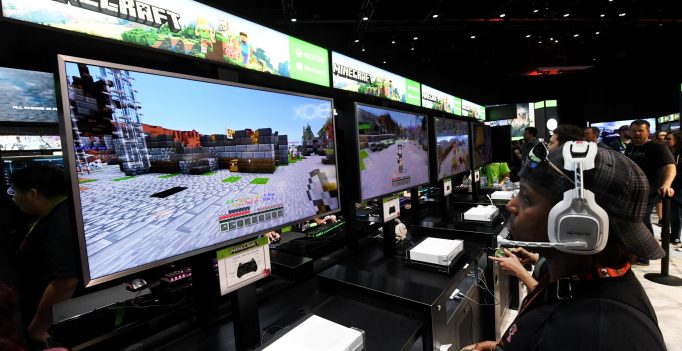Earlier in April, more than 60 million people were presented with a mission: Track down and vanquish a golden, fire-breathing dragon terrorizing a vulnerable village.
That is, a digital village in the metaverse of Minecraft, a videogame that allows its many users to explore and build their own worlds. In this new Minecraft minigame, “Heat Wave Survival,” players are facing up against the Heat Dragon, a villain developers created to represent the deadly threat of extreme heat as global temperatures rise.
This is just one of the many ways that climate change is infiltrating game night. Around the world, developers and designers are intentionally weaving climate change characters like the Heat Dragon, as well as potential solutions, into board games and video games to help engage users in the fight to slow global warming.
Today, we are exploring how the climate movement is growing within the gaming universe—and what that could mean for the real world.
Climate Gamers: The main goal of Minecraft’s “Heat Wave Survival” is to slay the mighty heat dragon, but throughout the mission, players get tips on how to recognize the symptoms of heat-related illnesses and the best ways to respond such as hydrating or finding a cool space, reports Fast Company.
The team, led by the nonprofit Adrienne Arsht-Rockefeller Foundation Resilience Center, is also developing a second game in its series in which players are in charge of building their own city supplied by renewable energy, with the option to install heat-resilient infrastructure such as shade structures. The games are primarily aimed at young students.
But this isn’t the first initiative of its kind. In 2019, the United Nations launched its Playing for the Planet Alliance, with the goal of helping the video game industry shrink its environmental footprint and engage its players in climate action.
Each year, the Alliance—which has dozens of members such as Sony and Google—hosts a “Green Game Jam,” where companies are encouraged to integrate more eco-friendly themes into their games. In 2023, developers added nature conservation elements into 41 games, Bloomberg reports. For example, the company Rovio Entertainment added a temporary new challenge to the popular game Angry Birds, in which users were tasked with saving virtual endangered animals in the Amazon.
However, the video game industry itself has its own emissions issues to reckon with. Along with the energy required to play a game, engineers use large amounts of energy to power computers during development, and manufacturing of game accessories and devices uses vast quantities of plastic and batteries, which can contribute to the growing problem of electronic waste after they are disposed of, Claire Asher writes for Mongabay.
In December, a CNET report found that “only a portion of gaming companies release climate impact data,” but that a growing number of developers are making efforts to reduce emissions through the use of renewable energy in their supply chains.
Clean Energy Simulations: Outside the virtual world, a new energy-oriented version of the classic board game “Settlers of Catan” is being released this summer. The original iteration was created in 1995 and tasked players with creating their own nation from scratch on an undeveloped island. The new game, dubbed “Catan: New Energies,” will introduce more of the modern-day struggles that come along with rapid industrial growth, and the emissions associated with them.
In the game, players must choose between investing in expensive clean energy options or low-cost but high-polluting fossil fuels (sound familiar?). Though “Catan: New Energies” does not outright mention the term climate change, if pollutant levels get too high, “the game ends in catastrophe” and the player with the most renewable energy tokens wins, according to Catan’s website.
Benjamin Teuber, co-developer of the new game, told NPR that during the development phase, the testing team would “always manage to over pollute.”
However, games offer unlimited chances to explore how to wrangle in runaway emissions: “We had heavy discussions afterwards,” Teuber said. “We all felt kind of bad, we learned a thing or two, and the next game we played differently.”
But what about the real world, where research shows that there won’t be unlimited opportunities to slow emissions before climate change irrevocably alters ecosystems and cities? Board games and simulations can “inspire players to learn about the climate crisis and motivate them to act,” Sam Illingworth, a game developer and science communications expert at Edinburgh Napier University in the United Kingdom, wrote in the Conversation.
“As we face the urgent challenges ahead, I believe that such games can play a crucial role in fostering understanding, dialogue and action.”
More Top Climate News
A new study published on Wednesday revealed the 65 companies responsible for more than half of the branded plastic pollution littering Earth. The brands topping the list (in order) were the Coca-Cola Company, PepsiCo and Nestlé. However, about half of the items the researchers surveyed overall were unbranded, which shows the gaps in producer reporting, the study says.
“What the data is saying is that if the status quo doesn’t change in a huge way—if social norms around the rapid consumption and production of new materials don’t change—we won’t see what we want,” Win Cowger, a researcher at the Moore Institute for Plastic Pollution Research and the study’s lead author, told Grist.
The study coincided with the start of the Global Plastic Treaty talks this week taking place in Canada, where countries have gathered to continue drafting the first-ever treaty to curb plastic pollution. However, experts say that this will be a tall task given the historic disagreements between governments and business leaders for how to handle the plastic pollution issue, Reuters reports.









